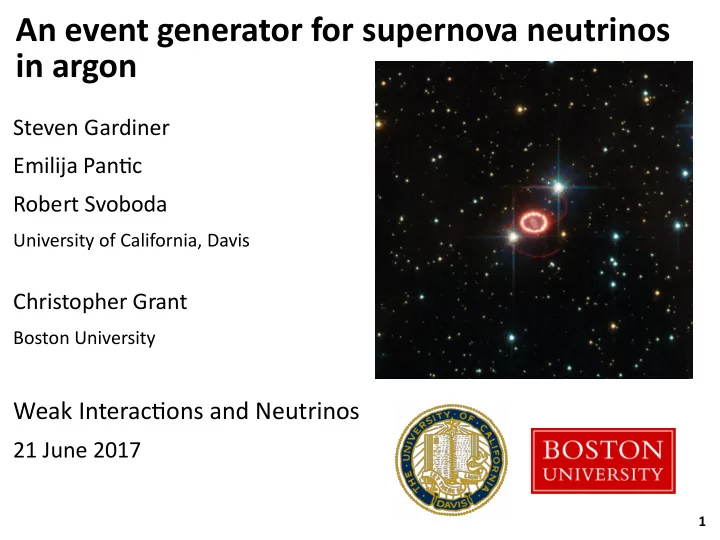

An event generator for supernova neutrinos in argon Steven Gardiner Emilija Pantjc Robert Svoboda University of California, Davis Christopher Grant Boston University Weak Interactjons and Neutrinos 21 June 2017 1
Outline ● Motjvatjon for argon-based supernova neutrino detectors ● Event reconstructjon challenges (why is this hard?) ● MARLEY : M odel of A rgon R eactjon L ow E nergy Y ields – Ingredients in our model – Example simulatjon results ● Current studies and future prospects 2
Water- and argon-based neutrino detectors have complementary sensitjvitjes to SN neutrinos 3
Supernova neutrino detectjon with water Cherenkov detectors ● Inverse beta decay is the dominant reactjon ● Number of detected photons gives a positron energy measurement ● From there, reconstructjng the antjneutrino energy is straightgorward inverse beta decay 4
5
The need for a supernova neutrino simulatjon tool ● Simulatjons are needed to understand LArTPC response to SN neutrinos ● A number of neutrino event generators exist, but the emphasis is on high-energy physics ● In the low tens-of-MeV regime, nuclear structure details become quite important! ● We have developed a new generator to help us understand the response of 40 Ar to SN neutrinos – Nuclear data measurements (levels, gammas, matrix elements) can help us 6
● Event generator for supernova neutrinos on 40 Ar ● Current version does CC (dominant channel) ● Framework allows adding new reactjons, target nuclei, etc. M odel of A rgon R eactjon L ow E nergy Y ields ● In use by DUNE for SN Bob Marley illustration by Zero Anixter simulatjons ● Also has users from several other liquid argon experiments 7
MARLEY event generatjon fmowchart Transmission coeffjcient model 8
9
10
World’s B(GT) data for 40 Ar ● Measurements using (p,n) scatuering vs. 40 Ti beta decay show signifjcant disagreements ● Hard to calculate and hard to measure! ● Karakoç, et al. Phys. Rev. C 89, 064313 (2014) refers to a third measurement that remains unpublished ● Must be supplemented by theory at higher energies 11
12
MARLEY’s cross sectjon agrees with similar calculatjons over much of the relevant energy range - * 4 0 4 0 T o t a l c r o s s s e c t i o n f o r + A r K + e ) ν → e 2 3 8 m − 1 0 c ( n o i t c e 3 9 − 1 0 s s s o r c 4 0 − 1 0 4 1 1 0 − 4 2 − 1 0 M A R L E Y 4 3 − 1 0 4 4 1 0 − 0 2 0 4 0 6 0 8 0 1 0 0 n e u t r i n o e n e r g y ( M e V ) ● Low energies = forbidden transitjons make a small contributjon below MARLEY’s hard cutof ● High energies = forbidden transitjons start to dominate near 100 MeV 13
MARLEY transmission coeffjcient model ● Unbound states in MARLEY de-excite according to the Hauser-Feshbach model – W. Hauser and H. Feshbach, Physical Review 87 , 366 (1952) – Successfully used for many years to describe nuclear cross sectjons – Work contjnues to refjne the input parameters (e.g., RIPL-3) – Used in many SN neutrino theory papers (in combinatjon with RPA, QRPA, etc.) – Two key assumptjons: 1. compound nucleus 2. reciprocity theorem (tjme-reversal invariance) ● Final states are sampled using decay widths 14
MARLEY transmission coeffjcient model ● Nuclear potentjal from Koning & Delaroche global optjcal model A. J. Koning and J. P. Delaroche, Nuclear Physics A 713 3-4 (2003) Solve radial Schrödinger equatjon numerically in matching region ● Match to asymptotjc solutjon, extract transmission coeffjcient ● Transmission coeffjcient represents the probability of 15 penetratjng the nuclear surface
L i v e r m o r e s u p e r n o v a s p e c t r u m 3 0 0 0 0 2 5 0 0 0 2 0 0 0 0 1 5 0 0 0 1 0 0 0 0 5 0 0 0 0 0 1 0 2 0 3 0 4 0 5 0 6 0 83.7% 14.6% 1.5% 16
17
18
19
20
21
22
Current studies and future prospects ● MARLEY development is ongoing – Interfaces to other codes (e.g., LArSofu) – Physics improvements – Preparatjon of data for other reactjon channels ● A variety of reconstructjon topics are beginning to be addressed using MARLEY events M odel of A rgon R eactjon L ow E nergy Y ields De-excitatjon vs. bremsstrahlung γ – Nucleon emission tagging – – Event t0 determinatjon SN triggering – – MC-based smearing matrix for SNOwGLoBES ● ACED : A rgon C apture E xperiment at D ANCE Measurement of 40 Ar thermal neutron capture cross – sectjon and event-by-event gammas Addresses key uncertaintjes in liquid argon response to – low energy neutrons The D etector for A dvanced N eutron C apture E xperiments at Los Alamos – First data this fall 23
Conclusion ● Nuclear efects greatly complicate supernova neutrino event reconstructjon in argon ● MARLEY is a new generator specifjcally targetjng supernova neutrinos in 40 Ar ● Studies are underway to learn how to reconstruct these events in DUNE ● A direct measurement of these cross sectjons M odel of A rgon R eactjon L ow E nergy Y ields would be very valuable! – See C. McGrew’s CAPTAIN talk for one proposed experiment ● Want to become a MARLEY user or developer? Email me at support@marleygen.org for more 24 informatjon
Recommend
More recommend